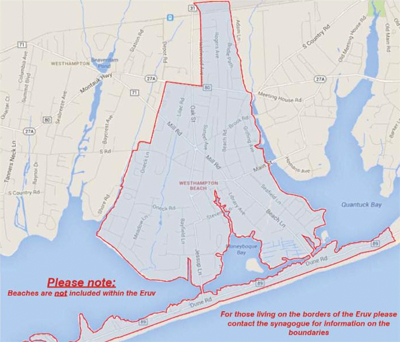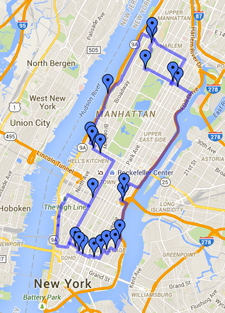The June 30 ruling by Justice Joseph Farneti that proposed Jewish markers on utility poles in Southampton would be "invisible" has been called "outrageous" by Arnold Sheiffer, chairman, Jewish People for the Betterment of Westhampton Beach.
 WHB eruv map WHB eruv map |
Sheiffer, in a letter to the July 30 Southampton Press, which has urged WHB to stop fighting erection of an eruv and which also referred to the proposed markers as "invisible," says the boundaries are highly visible because "I see on websites the exact map showing the area encircled by these religious symbols."
"Whether I can see the convoluted poles, wires and symbols that make up lechis is irrelevant," he wrote.
What is needed, according to Sheiffer, whose group represents about 300 Reformed Jews and others who are residents of WHB, is a judge with the “judicial fortitude to issue a ruling that could be the basis of causing all eruvs in the U.S. to be taken down."
Continued Sheiffer: "I and many of my fellow members are of a generation where our parents and grandparents were victims of the Holocaust. We had an unspoken vow that we would never be herded into ghettos again. These lechis create a ghetto-like Orthodox Jewish community. We don’t need to see that they are installed on poles."
"It's very sad when no judge has the strength to follow our freedom of religion laws because of the political clout of the Orthodox in this state,” he continued, adding, "Can you imagine the uproar if Protestants or Catholics asked to install crosses on utility poles? Our public right-of-ways are not for posting religious symbols."
Sheiffer Made Good Points
Sheiffer is being very kind to judges when he says they lack "fortitude." We would use the word "guts."
The New York Post, writing about the July 20 suicide of 30-year-old Faigy Mayer, who had been ostracized from her ultra-Orthodox sect because she challenged its beliefs, said the ultra-Orthodox number “upward of 400,000” in the New York area and are a potent political and economic force.
Only one judge has correctly analyzed what is going on in the disputes about eruvim—New Jersey Federal District Judge William Bassler, who ruled in 2001 in the Tenafly case that “public property should not be permanently allocated to a religious purpose.” All six Tenafly board members agreed in lengthy statements.
Judge Thomas Ambro, of the Third Circuit Appeals Court in Wilmington, Del., upset the ruling in 2002 by comparing lechis to lost pet signs, orange ribbons put on poles by high school students, temporary Christmas holiday displays, and directional signs bearing crosses. That was a case of faulty reasoning and similar to the June 30 decision.
Media Collapse Before Orthodox Onslaught
The SH Press/27east.com, with about 22,000 circulation, has collapsed before the ultra-Orthodox onslaught, starting an editorial July 23 with the words, “Nobody can see the lechis that reportedly mark the boundaries of an eruv…” It urges acceptance of the “roof” of an eruv, although an eruv is supposed to be a “wall,” and says the lechis are “not signs if they are not visible.”
Occupants of cars are not going to see lechis as they whiz by utility poles at 35-40 miles per hour. We grant that. The poles would be on the outskirts of town where few pedestrians are found. Eruvim are on websites of Synagogues and sometimes on Google Maps, which is the case with Manhattan.
Eruv lawsuits have endless arguing over what is a sign and what isn’t. It is as though the normal meaning of the word “sign” was an apple and someone smashed it numerous times with a hammer until it was a pulpy mess bearing no resemblance to its natural state. The same thing is done to the word “accommodation.” Its normal meaning is stretched far beyond the breaking point.
A town could accommodate a religious or ethnic group by allowing it to use Main street for a parade. But renaming the street permanently for the group would be stretching that word. That is what an eruv does.
 Manhattan eruv Manhattan eruv |
Also AWOL on the Hamptons eruvim story is the New York Times, whose last article on it was Feb. 4, 2013. NYT also skipped the suicide of Faigy Mayer.
The biggest Long Island paper, Newsday, with 437,000 circulation, owned by Cablevision, has given it little attention. Ditto for local media such as Dan’s Papers, The Independent of East Hampton headed by adman Jerry Della Femina, East End Beacon website, and Patch, the local branch of a nationwide news service. We think it’s a case of the “Two C’s”—too complicated and too controversial. The (Jewish Daily) Forward, New York Observer and tabletmag.com have also lightly covered eruvim. The Journalism school of nearby Stonybrook University has shown no interest in it.
Town Websites, Libraries Skip Issue
Websites of WHB, SH, Quogue and Hampton Bays mostly skip the issue. Last item under the title of “Eruv Litigation” on the WHB website is Dec. 22, 2014. Most of the items are from 2011. Missing are such key documents as the 6,000-word transcript of the conference before Judge Kathleen Tomlinson Feb. 26, 2015, at which both sides presented their best cases; the Jan. 6, 2015 Appeals Court decision, and the June 30 Suffolk County Supreme Court decision.
Towns choking off the information flow on this matter is beyond mere stonewalling and into censorship.
Hamptons, Singles Need Organization
The root cause of the invasion of the ultra-Orthodox is that WHB and the other towns have driven out the singles who used to support the restaurants and nightclubs in their areas. Brandon Quinn, writing in the SH Press Dec. 15, 2014, clocked more than 20 nightclubs and restaurants closing in SH because of the crackdown on the number of unrelated people allowed to rent a house. WHB lost not only a dozen clubs and eateries but three of its five gas stations. Large tracts of land near WHB's Main street are vacant.
WHB and the ultra-Orthodox have been trying to fill this vacuum but ultra-Orthodox will not come without an eruv, which violates church/state separation.
What’s needed is for the political leaders of Hamptons communities to get together to form a policy for “groupie” houses that is not as strict as at present. How about “accommodating” the singles is our question? They have been chased to Montauk Point, the end of the island, where the Independent said in an editorial July 23 that “the sheer number of late night revelers has overrun the place. There are too many cars, too many drinkers, too many drunks.”
Singles are in the dead-serious and important game of finding a mate. Almost all of them are law-abiding. What they should do is police themselves. Publicize a number that residents can call if too much noise is being made or there are other abuses. Volunteer singles “wardens” can keep the few boisterous in line.
Also AWOL in this controversy are the state and national political leaders. Citizens may have to take matters into their own hands.


 Husch Blackwell Strategies has added FleishmanHillard alum Michael Slatin as a principal in its public affairs group.
Husch Blackwell Strategies has added FleishmanHillard alum Michael Slatin as a principal in its public affairs group. Rory Cooper, a veteran Republican operative and policy specialist, has joined Teneo’s Washington office as senior managing director in its strategy & communications practice.
Rory Cooper, a veteran Republican operative and policy specialist, has joined Teneo’s Washington office as senior managing director in its strategy & communications practice. Brian Fallon, who served as national press secretary for Hillary Clinton’s 2016 presidential run, is signing on next month as Vice President’s Kamala Harris’ campaign communications director.
Brian Fallon, who served as national press secretary for Hillary Clinton’s 2016 presidential run, is signing on next month as Vice President’s Kamala Harris’ campaign communications director. TikTok is nothing more than a Chinese propaganda tool that poses “a grave threat to America’s national security and, in particular, impressionable children and young adults,” say two Congressmen who want the platform registered as a foreign agent.
TikTok is nothing more than a Chinese propaganda tool that poses “a grave threat to America’s national security and, in particular, impressionable children and young adults,” say two Congressmen who want the platform registered as a foreign agent. Public Strategies Washington has added Abbie Sorrendino, a former aide to now Senate Majority Leader Chuck Schumer.
Public Strategies Washington has added Abbie Sorrendino, a former aide to now Senate Majority Leader Chuck Schumer.


 Have a comment? Send it to
Have a comment? Send it to 
No comments have been submitted for this story yet.